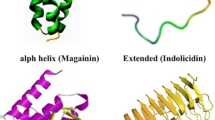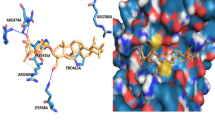Abstract
Antimicrobial peptides which play a vital role in an innate immune defense mechanism of various organisms can be regarded as novel therapeutic agents for targeted therapy to cure cancer. In the present study, a novel antimicrobial peptide which has a prominent anticancer property was identified by investigating the binding efficiency of it with the target protein, β-catenin, and named as SKACP003. Further SKACP003 was synthesized chemically and its cytotoxic effect against the following breast cancer cell lines, namely, MCF-7, MDA-MB-231 and MDA-MB-453 were explored. It was observed that SKACP003 induced dose-dependent cytotoxicity in all the above mentioned cell lines. Moreover, by using the AO/EB, Hoechst, and JC1 staining procedures we recokned that the peptide SKACP003 brought out effective morphological changes, apoptosis, and mitochondrial membrane potential loss, respectively, on the three cell lines considered. In addition to that, there was a great extent of DNA damage noticed in the cell lines concerned with the aid of comet assay. Altogether, we conclude that the anticancer property of SKACP003 can be meticulously invoked, after further evaluations at the molecular level to design a new valiant drug, to cure breast cancer.













Similar content being viewed by others
References
Bamodu OA, Huang WC, Tzeng DT, Wu A, Wang LS, Yeh CT, Chao TY (2015) Ovatodiolide sensitizes aggressive breast cancer cells to doxorubicin, eliminates their cancer stem cell-like phenotype, and reduces doxorubicin-associated toxicity. Cancer Lett 364(2):125–134
Bourzac K (2012) Nanotechnology: carrying drugs. Nature 491(7425):S58
Clevers H, Nusse R (2012) Wnt/β-catenin signaling and disease. Cell 149(6):1192–1205
Coleman MP, Quaresma M, Berrino F, Lutz JM, De Angelis R, Capocaccia R, Micheli A (2008) Cancer survival in five continents: a worldwide population-based study (CONCORD). Lancet Oncol 9(8):730–756
Dennison SR, Whittaker M, Harris F, Phoenix DA (2006) Anticancer α-helical peptides and structure/function relationships underpinning their interactions with tumour cell membranes. Curr Protein Peptide Sci 7(6):487–499
Elmore S (2007) Apoptosis: a review of programmed cell death. Toxicol Pathol 35(4):495–516
Ghafoor A, Jemal A, Ward E, Cokkinides V, Smith R, Thun M (2003) Trends in breast cancer by race and ethnicity. CA A Cancer J Clin 53(6):342–355
Graham TA, Ferkey DM, Mao F, Kimelman D, Xu W (2001) Tcf4 can specifically recognize β-catenin using alternative conformations. Nat Struct Mol Biol 8(12):1048
Green DR, Reed JC (1998) Mitochondria and apoptosis. Science 281(5381):1309–1312
Harris F, Dennison SR, Singh J, Phoenix DA (2013) On the selectivity and efficacy of defense peptides with respect to cancer cells. Med Res Rev 33(1):190–234
He TC, Sparks AB, Rago C, Hermeking H, Zawel L, Da Costa LT, Morin PJ, Vogelstein B, Kinzler KW (1998) Identification of c-MYC as a target of the APC pathway. Science 281(5382):1509–1512
Hilchie AL, Doucette CD, Pinto DM, Patrzykat A, Douglas S, Hoskin DW (2011) Pleurocidin-family cationic antimicrobial peptides are cytolytic for breast carcinoma cells and prevent growth of tumor xenografts. Br Can Res 13(5):R102
Hovanes K, Li TW, Munguia JE, Truong T, Milovanovic T, Marsh JL, Waterman ML (2001) β-catenin-sensitive isoforms of lymphoid enhancer factor-1 are selectively expressed in colon cancer. Nat Genet 28(1):53
Huang YB, Wang XF, Wang HY, Liu Y, Chen Y (2011) Studies on mechanism of action of anticancer peptides by modulation of hydrophobicity within a defined structural framework. Mol Can Ther 10(3):416–426
Iijima M, Uhara H, Ide Y, Sakai S, Onuma H, Muto M, Hayashi K, Mitsura F, Kobayashi S, Yoshizawa A, Saida T (2006) Estrogen-receptor-alpha-positive extramammary Paget’s disease treated with hormonal therapy. Dermatology 213(2):144–146
Kahn M (2014) Can we safely target the WNT pathway? Nat Rev Drug Discov 13(7):513–532
Kasibhatla S, Amarante-Mendes GP, Finucane D, Brunner T, Bossy-Wetzel E, Green DR (2006) Staining of suspension cells with Hoechst 33258 to detect apoptosis. CSH Protoc. https://doi.org/10.1101/pdb.prot4492
Khramtsov AI, Khramtsova GF, Tretiakova M, Huo D, Olopade OI, Goss KH (2010) Wnt/β-catenin pathway activation is enriched in basal-like breast cancers and predicts poor outcome. Am J Pathol 176(6):2911–2920
King TD, Suto MJ, Li Y (2012) The wnt/-catenin signaling pathway: A potential therapeutic target in the treatment of triple negative breast cancer. J Cell Biochem 113(1):13–18
Kirstetter P, Anderson K, Porse BT, Jacobsen SEW, Nerlov C (2006) Activation of the canonical Wnt pathway leads to loss of hematopoietic stem cell repopulation and multilineage differentiation block. Nat Immunol 7(10):1048
Koval A, Katanaev VL (2018) Dramatic dysbalancing of the Wnt pathway in breast cancers. Sci Rep 8(1):7329
Kumar RS, Riyasdeen A, Dinesh M, Paul CP, Srinag S, Krishnamurthy H, Arunachalam S, Akbarsha MA (2011) Cytotoxic property of surfactant-cobalt (III) complexes on a human breast cancer cell line. Archiv Pharm 344(7):422–430
Kumar R, Verma V, Sarswat A, Maikhuri JP, Jain A, Jain RK, Gupta G (2012) Selective estrogen receptor modulators regulate stromal proliferation in human benign prostatic hyperplasia by multiple beneficial mechanisms—action of two new agents. Investig New Drugs 30(2):582–593
Lengacher CA, Reich RR, Paterson CL, Ramesar S, Park JY, Alinat C, Jacobsen PB (2016) Examination of broad symptom improvement resulting from mindfulness-based stress reduction in breast cancer survivors: a randomized controlled trial. J Clin Oncol 34(24):2827
Lenz HJ, Kahn M (2014) Safely targeting cancer stem cells via selective catenin coactivator antagonism. Cancer Sci 105(9):1087–1092
Lim KJ, Sung BH, Shin JR, Lee YW, Yang KS, Kim SC (2013) A cancer specific cell-penetrating peptide, BR2, for the efficient delivery of an scFv into cancer cells. PLoS ONE 8(6):e66084
Lin SY, Xia W, Wang JC, Kwong KY, Spohn B, Wen Y, Hung MC (2000) β-catenin, a novel prognostic marker for breast cancer: its roles in cyclin D1 expression and cancer progression. Proc Natl Acad Sci 97(8):4262–4266
Loganathan L, Muthusamy K (2018) Current scenario in structure and ligand-based drug design on anti-colon cancer drugs. Curr Pharm Des 24(32):3829–3841
Loganathan L, Muthusamy K (2019) Investigation of drug interaction potentials and binding modes on direct renin inhibitors: a computational modeling studies. Lett Drug Des Dis 16(8):919–938
Mader JS, Honskin DW (2006) Cationic antimicrobial peptides as novel cytotoxic agents for cancer treatment. Expert Opin Investig Drugs 15:933–946
Mantyh PW, Clohisy DR, Koltzenburg M, Hunt SP (2002) Molecular mechanisms of cancer pain. Nat Rev Cancer 2(3):201
Matsuzaki K, Sugishita KI, Harada M, Fujii N, Miyajima K (1997) Interactions of an antimicrobial peptide, Magainin 2, with outer and inner membranes of gram negative bacteria. Biochim Biophys Acta (BBA) Bio Membr 1327(1):119–130
Morad SA, Levin JC, Tan SF, Fox TE, Feith DJ, Cabot MC (1831) (2013) Novel off-target effect of tamoxifen—inhibition of acid ceramidase activity in cancer cells. Biochim Biophys Acta (BBA) Mol Cell Biol Lipids 12:1657–1664
Novkovic M, Simunic J, Bojovic V, Tossi A, Juretic D (2012) DADP: the database of anuran defense peptides. Bioinformatics 28(10):1406–1407
Olive PL, Banáth JP (1995) Sizing highly fragmented DNA in individual apoptotic cells using the comet assay and a DNA crosslinking agent. Exp Cell Res 221(1):19–26
Ozaki S, Ikeda S, Ishizaki Y, Kurihara T, Tokumoto N, Iseki M, Arihiro K, Kataoka T, Okajima M, Asahara T (2005) Alterations and correlations of the components in the Wnt signaling pathway and its target genes in breast cancer. Oncol Rep 14(6):1437–1443
Prosperi R, Goss H (2010) A Wnt-ow of opportunity: targeting the Wnt/β-catenin pathway in breast cancer. Curr Drug Targets 11(9):1074–1088
Prosperi JR, Khramtsov AI, Khramtsova GF, Goss KH (2011) Apc mutation enhances PyMT-induced mammary tumorigenesis. PLoS ONE 6(12):e29339
PyMOL (2017). The PyMOL Molecular Graphics System, Version 2.0
Rahmani F, Tabrizi AT, Hashemian P, Alijannejad S, Rahdar HA, Ferns GA, Hassanian SM, Shahidsales S, Avan A (2020) Role of regulatory miRNAs of the Wnt/β-catenin signaling pathway in tumorigenesis of breast cancer. Gene 10:144892
Reers M, Smith TW, Chen LB (1991) J-aggregate formation of a carbocyanine as a quantitative fluorescent indicator of membrane potential. Biochem 30(18):4480–4486
Release, S. (2017) 4: Maestro, Schr¨dinger, LLC, New York, NY, 2017. Schrödinger Inc.
Roberts MG (2016) Investigating the effects of nucleosome remodeling factor knockdown on anti-tumor immunity, M.Sc. Thesis, Virginia Commonwealth University, Richmond, VA
Schnitt SJ (2010) Classification and prognosis of invasive breast cancer: from morphology to molecular taxonomy. Modern Pathol 23(S2):S60
Schweizer F (2009) Cationic amphiphilic peptides with cancer-selective toxicity. Eur J Pharm 625(1–3):190–194
Seifert, E. (2014). OriginPro 9.1: Scientific Data Analysis and Graphing Software, Software Review.
Selvam R, Subashchandran KP (2015) Synthesis of biologically active hydrophobic peptide by using novel polymer support: improved Fmoc solid phase methodology. Int J Pep Res Ther 21(1):91–97
Shi S, Chen X, Liu H, Yu K, Bao Y, Chai J, Gao H, Zou L (2019) LGR5 acts as a target of miR-340-5p in the suppression of cell progression and drug resistance in breast cancer via Wnt/β-catenin pathway. Gene 683:47–53
Singh NP, McCoy MT, Tice RR, Schneider EL (1988) A simple technique for quantitation of low levels of DNA damage in individual cells. Exp Cell Res 175(1):184–191
Spector DL, Goldman RD, Leinwand LA (1998) Culture and biochemical analysis of cells. Cell 1: 34.1–34.9
van der Spoel D, van Maaren PJ, Caleman C (2012) GROMACS molecule and liquid database. Bioinformatics 28(5):752–753
Trellet M, Melquiond AS, Bonvin AM (2013) A unified conformational selection and induced fit approach to protein-peptide docking. PLoS ONE 8(3):e58769
Turashvili G, Bouchal J, Burkadze G, Kolar Z (2006) Wnt signaling pathway in mammary gland development and carcinogenesis. Pathobiology 73(5):213–223
Tyagi A, Kapoor P, Kumar R, Chaudhary K, Gautam A, Raghava GPS (2013) In silico models for designing and discovering novel anticancer peptides. Sci Rep 3:2984
Valenta T, Hausmann G, Basler K (2012) The many faces and functions of β-catenin. EMBO J 31(12):2714–2736
Waghu FH, Barai RS, Gurung P, Idicula-Thomas S (2015) CAMPR3: a database on sequences, structures and signatures of antimicrobial peptides. Nucl Acids Res 44(D1):D1094–D1097
Wang G, Li X, Wang Z (2015) APD3: The antimicrobial peptide database as a tool for research and education. Nucl Acids Res 44(D1):D1087–D1093
World Health Organization (2016) WHO media centre: cancer. http://www.who.int/cancer/en/. Accessed on 26 Jun 2017
Yang L, Cui Y, Shen J, Lin F, Wang X, Long M, Zhang H (2015) Antitumor activity of SA12, a novel peptide, on SKBr-3 breast cancer cells via the mitochondrial apoptosis pathway. Drug Design Dev Ther 9:1319
Yook JI, Li XY, Ota I, Hu C, Kim HS, Kim NH, Fearon ER (2006) A Wnt–Axin2–GSK3β cascade regulates Snail1 activity in breast cancer cells. Nat Cell Biol 8(12):1398
Yu QC, Verheyen EM, Zeng YA (2016) Mammary development and breast cancer: a Wnt perspective. Cancers 8(7):65
Zasloff M (1987) Magainins, a class of antimicrobial peptides from Xenopus skin isolation, characterization of two active forms, and partial cDNA sequence of a precursor. Proc Natl Acad Sci 84(15):5449–5453
Van Zundert GCP, Rodrigues JPGLM, Trellet M, Schmitz C, Kastritis PL, Karaca E, Melquiond AS, van Dijk M, De Vries SJ, Bonvin AMJJ (2016) The HADDOCK 2.2 web server: user-friendly integrative modeling of biomolecular complexes. J Mol Biol 428(4):720–725
Acknowledgements
Authors acknowledge the help received from Prof. R. Thirumurugan, Department of Animal Science, Bharathidasan University, Tiruchirapalli—620 024, India. Also the authors wish to acknowledge the support received from Dr. M. Karthikeyan and Mr. L. Lakshmanan, Department of Bioinformatics, Alagappa University, Karaikudi-630 003, India in the form of docking studies.
Author information
Authors and Affiliations
Corresponding author
Ethics declarations
Conflict of interest
The authors SK, TM, BB, and VR declare that they have no conflict of interest.
Ethical approval
This article does not contain any studies with human participants or animals performed by any of the authors.
Additional information
Publisher's Note
Springer Nature remains neutral with regard to jurisdictional claims in published maps and institutional affiliations.
Rights and permissions
About this article
Cite this article
Selvarathinam, K., Thekkumalai, M., Perumalsamy, B. et al. Design and Synthesis of a Novel Antimicrobial Peptide Targeting β-catenin in Human Breast Cancer Cell lines. Int J Pept Res Ther 27, 1849–1860 (2021). https://doi.org/10.1007/s10989-021-10215-x
Accepted:
Published:
Issue Date:
DOI: https://doi.org/10.1007/s10989-021-10215-x




